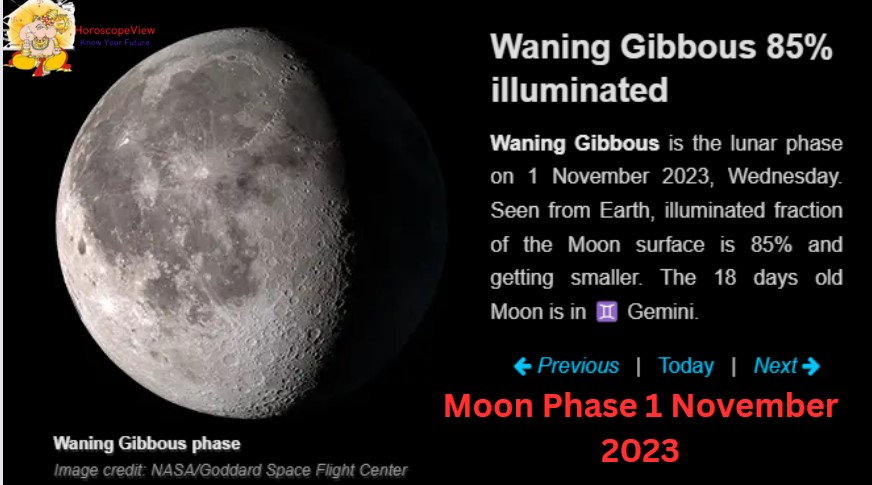Moon Phase November 01, 2023: On November 1, 2023, the Moon will be in the Waning Gibbous phase. This phase is observed in the early morning hours on the western horizon. It follows the Full Moon and lasts approximately 7 days, with the Moon’s illumination decreasing each day until it becomes a Last Quarter Moon, with an illumination of 50%.
Moon Phase Today November 1 2023
- Phase Details For – November 1
- Phase: Waning Gibbous
- Illumination: 85%
- Moon Age: 18.56 days
- Moon Angle: 0.51
- Moon Distance: 391,188.25 km
- Sun Angle: 0.54
- Sun Distance: 148,460,100.76 km
The Moonrise time for this phase is typically between 9pm and Midnight, varying depending on the age of the phase. As the days progress, the Moon rises later and later, setting after sunrise in the morning.
To view all the daily moon phases for November 2023, please refer to the November 2023 Moon Phases Calendar. Waning Gibbous Phase On November 1, the Waning Gibbous phase will have an illumination of 85%. This represents the percentage of the Moon’s surface illuminated by the Sun.
The illumination constantly fluctuates and can vary up to 10% each day. The Moon will be 18.56 days old on November 1, indicating the number of days since the last New Moon. It takes approximately 29.53 days for the Moon to complete its orbit around the Earth and go through all 8 phases of the lunar cycle.
Phase Details For – November 1 Phase: Waning Gibbous Illumination: 85% Moon Age: 18.56 days Moon Angle: 0.51 Moon Distance: 391,188.25 km Sun Angle: 0.54 Sun Distance: 148,460,100.76 km.
Waning Gibbous 85% illuminated
On November 1, 2023, the Waning Gibbous phase will be observed. From the perspective of Earth, 85% of the Moon’s surface will be illuminated by the Sun, and this illumination will gradually decrease. The Moon, at 18 days old, will be in the constellation of Gemini (♊).
The Moon phase for November 1st, 2023 is a Waning Gibbous phase. This phase follows the Full Moon and is characterized by a gradual decrease in the Moon’s illumination each day until it reaches 50% during the Last Quarter phase.
During the Waning Gibbous phase, the Moon will rise after sunset in the east, reach its highest point in the sky after midnight, and then set in the west after sunrise. The illumination of the Moon will decrease from 99.9% to 50.1%.
While the phase technically begins as soon as the Full Moon is over, it can be challenging to discern the initial stage of a Waning Gibbous Moon from a Full Moon when approximately 98-99% of the Moon’s surface is still illuminated.
Fun fact: The term “Gibbous” originated in the 14th century and is derived from the Latin word “gibbosus,” which means humpbacked.


Leave a Reply